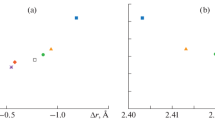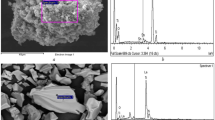Conclusions
-
1.
An Investigation was carried out into the variation of the coefficients of linear thermal expansion, thermal conductivities, and electrical resistivities of titanium carbonitrides and oxycarbides with temperature and composition. The thermal conductivities of these compounds were found to grow with rise in temperature.
-
2.
It is shown that the thermal and electrical conductivity isotherms of these compounds pass through extreme points, with a minimum of ρ and a maximum of λ at compositions close to TiC0.3N0.6 (which are attributable to ordering in the metalloid sublattice). By contrast, the coefficients of thermal expansion slightly grow with increase in nitrogen concentration in the whole composition range.
-
3.
No apparent correlation was found between the λ and ρ vs composition curves for titanium oxycarbides: While λ monotonically decreases with rise in oxygen concentration, ρ at first (up to y =0.4) slightly decreases and only then begins to increase rapidly with rise in y. Such changes are evidently attributable to complex changes in both the electron and phonon spectra, which in turn are due to increased defectiveness of both sublattices and increased contributions from ionic interactions at higher oxygen contents and also to ordering in the nonmetal sublattice (at approximately equal concentrations).
Similar content being viewed by others
Literature cited
V. S. Neshpor, G. M. Klimashin, and V. P. Nikitin, “Gaivanomagnetic and electrical properties of TiC-TiO, TiN-TiO, TiC-TiN, and ZrC-ZrN alloys,” in: Refractory Carbides [in Russian], Naukova Dumka, Kiev (1970), pp. 169–183.
G. V. Samsonov, G. Sh. Upadkhaya, and V. S. Neshpor, Physical Materials Science of Carbides [in Russian], Naukova Dumka, Kiev (1974).
S. I. Alyamovskii, B. V. Mitrofanov, et al., “Coefficients of thermal expansion of titanium carbonitrides,” Teplofiz. Vys. Temp.,11, 680–682 (1973).
S. I. Alyamovskii, Yu. G. Zainullin, et al., “Thermal expansion of titanium oxycarbides and oxynitrides with the NaCl structure,” Izv. Akad. Nauk SSSR, Neorg. Mater.,8, No. 10, 1770–1773 (1972).
N. A. Ivanov, “Elastic and thermophysical properties of titanium, zirconium, and niobium carbonitrides and oxycarbides,” Author's Abstract of Candidate's Dissertation, UPI, Sverdlovsk (1975).
S. I. Novikova, Thermal Expansion of Solids [in Russian], Nauka, Moscow (1974).
F. I. Ostrovskii, “Thermal conductivities and diffusivities of the monosilicides and higher suicides of the 3d transition metals,” Author's Abstract of Candidate's Dissertation, UPI, Sverdlovsk (1970).
P. I. Mal'ko, V. F. Nemchenko, and S. I. L'vov, “Calculation of the thermal and electrical conductivities of porous tungsten by means of unified conduction formulas,” Poroshk. Metall., No. 7, 55–59 (1968).
K. Y. Wu and Taylor, “Transport properties of transition metal carbides,” Adv. Therm. Cond. Pap., 12th Int. Conf., Mo., TU, QOUR (1974).
L, E. Toth, Transition Metal Carbides and Nitrides, Academic Press (1971).
S. N. L'vov, M. I. Lesnaya, I. M. Vinitskii, and V. Ya. Naumenko, “Thermal conductivities of some refractory carbides and borides,” Teplofiz. Vys. Temp.,10, No. 6, 1327–1329 (1972).
L. B. Dubrovskaya, B. V. Mitrofanov, et al., “Magnetic susceptibility and electric resistivity of carbonitrides,” Phys. Status Solidi,25, 67–171 (1974).
V. S. Oskot-skii and I. A. Smirnov, Defects in Crystals and Heat Conduction [in Russian], Nauka, Leningrad (1972).
J. M. Ziman, Electrons and Phonons, Oxford Univ. Press (1960).
B. V. Zubkov, I. I. Matveenko, et al., “A neutron diffraction investigation of the structure of titanium oxycarbides,” Dokl. Akad. Nauk SSSR,191, No. 2, 323–325 (1970).
Author information
Authors and Affiliations
Additional information
Translated from Poroshkovaya Metallurgiya, No. 8(188), pp. 54–58, August, 1978.
Rights and permissions
About this article
Cite this article
Ivanov, N.A., Andreeva, L.P. & Gel'd, P.V. Thermal conductivities, electrical resistivities, and thermal expansion of titanium carbonitrides and oxycarbides. Powder Metall Met Ceram 17, 613–616 (1978). https://doi.org/10.1007/BF00797336
Received:
Issue Date:
DOI: https://doi.org/10.1007/BF00797336




